Saga of the Moon Priestess is a retro top-down action and adventure videogame set in a fantasy kingdom whose prince has been abducted by a shadowy villain. I play as Sarissa, a girl with the ability to speak with the Goddess of the Moon. At the urging of this deity, Sarissa arms herself with a spear and sets out to find the prince and defeat his abductor. The short adventure takes her through five dungeons with few frills, uncovering in each a new tool that expands where she may travel around the kingdom and lets her reach new hidden upgrades. The more tools and upgrades Sarissa is able to accumulate, the better prepared she will be for the final confrontation with the prince’s mysterious kidnapper.
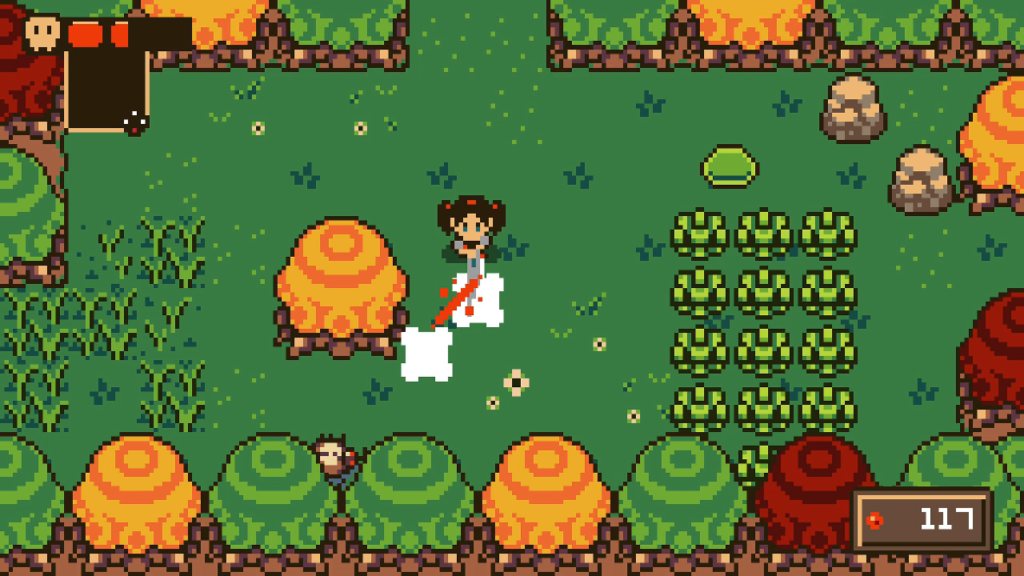
My general policy on this website is to avoid directly comparing the subject of a review to another videogame. I have observed this usually leads to spending more time talking about that other videogame, with specific details about what the subject does and how well it does it getting lost in the contrasts. This is a general policy and not a firm one because sometimes the comparison is unavoidable. Saga of the Moon Priestess is one such example. It is a reverent, miniaturized echo of the 1993 Game Boy classic The Legend of Zelda: Link’s Awakening. From its presentation to its puzzles to its level design, its form is unmistakable, indulging in the sincerest form of flattery towards one of Link’s most distinctive and iconic adventures.
Sarissa enters the world in a forest clearing next to a statue of the Moon Goddess. These statues appear across the kingdom and act as save points. Examining the statue causes the Goddess to speak to Sarissa, exhorting her to find the kidnapped prince.
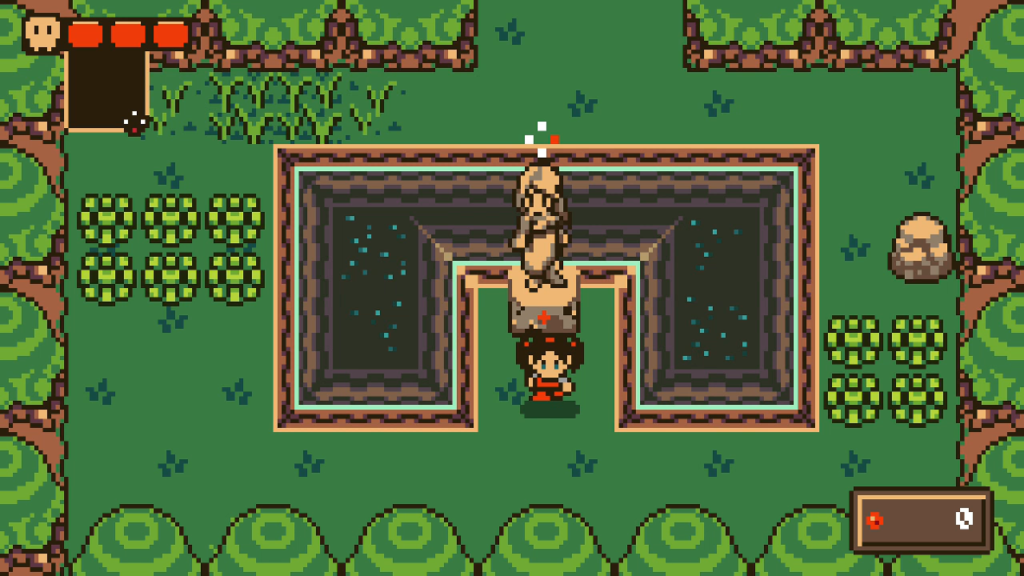
Wandering through the surrounding forest, Sarissa encounters many familiar sights. By cutting away bushes with her spear, she can gather hearts that restore her health bar. Some bushes also drop red and blue beads which may be traded in a shop for health-restoring potions. Apart from bushes, large rocks appear on many screens, including several clustered into crude barriers blocking the passageways to adjacent areas. Another route is blocked by a red crystal. Sarissa’s spear cannot remove these obstacles, but I know that, before long, she will find the tools which can.
A few screens north and west from where Sarissa’s journey begins, we discover the kingdom’s one and only town. Its citizens are an eclectic bunch. There’s a talking frog. A bratty boy. A man with an enormous walrus mustache. Near them stands a dwarf wearing a large helmet that hides his face, pulled directly from the World of Mana series. None of them have anything useful to say.
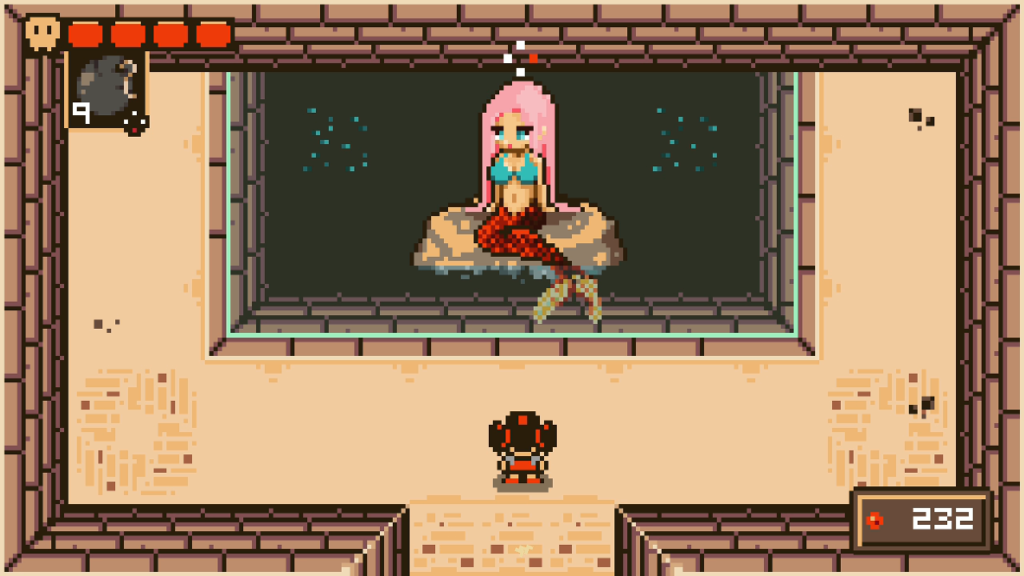
It’s the town’s shopkeeper who stands out most. She’s a woman with an enormous bosom. Her idle animation emphasizes this feature, rocking back and forth like she is shimmying to a song far raunchier than the town’s serene background music. She foreshadows other non-player characters Sarissa encounters on her adventure. Many are preternaturally endowed with simple animations that emphasize the effects of gravity on their bodies. These animations don’t feel denigrating, but they do feel gratuitous, as though a designer is indulging in their appetites in a place that doesn’t really call for them. Sarissa, thankfully, is spared from this distracting and lascivious portrayal.
Wandering in the opposite direction of the town, Sarissa discovers the first dungeon. Its structure also feels familiar. Rooms are laid out on a grid connected by irregular doorways, creating a simple maze. Some doors are locked by keys. Others contain stairsets that lead to faraway sections of the dungeon. Most rooms contain some kind of reward, usually a key, that is given to Sarissa for completing a puzzle or defeating every enemy within its walls. Fully exploring the dungeon, finding every key, and solving every puzzle gives Sarissa access to the dungeon’s final room, where an encounter with a powerful boss enemy awaits.
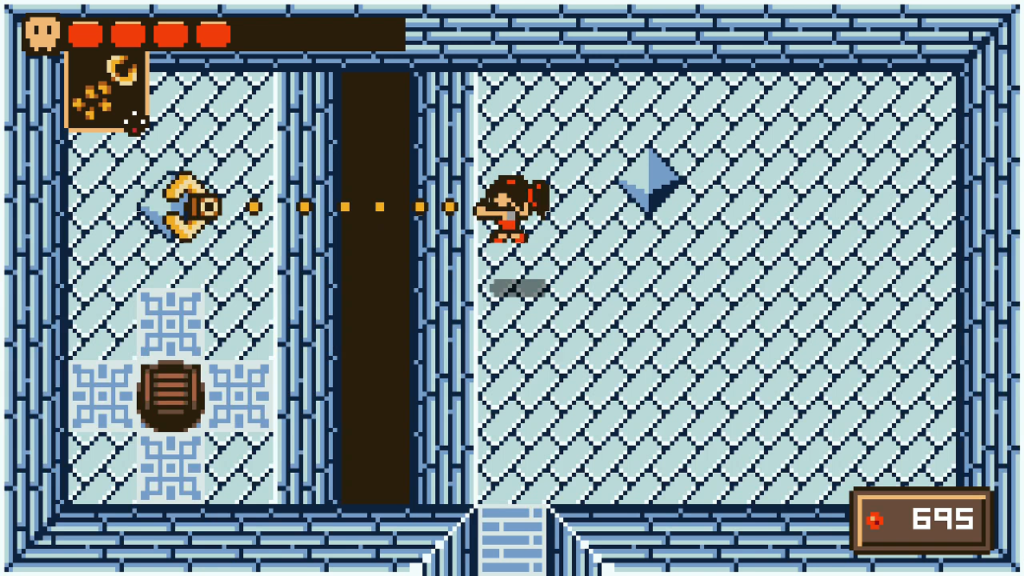
The special items Sarissa discovers in each dungeon are where Saga of the Moon Priestess most openly evokes The Legend of Zelda’s Game Boy outings. A magic glove lets her lift and throw heavy boulders out of her path—and preferably onto the head of a nearby enemy. Bombs reveal passages covered by fragile walls. A bow fires arrows into both enemies and targets that activate nearby mechanisms. The most blatant item pilfered is the Swap Chain, which fires a claw across the room that swaps Sarissa’s place with special targets, usually letting her cross an otherwise impassable pit. It is identical in function to Oracle of Ages’ Switch Hook, down to interacting with objects shaped like diamonds.
Despite these familiar mechanisms borrowed from an oft-imitated videogame, I still found myself admiring a few of the puzzles that stymie Sarissa’s path to each boss. Every dungeon has at least one puzzle that demonstrates some design ingenuity instead of rotely recreating something that Link solves in one of his adventures. Though none of Sarissa’s tools are original, they are still exploited with craftful thought on at least a few occasions.
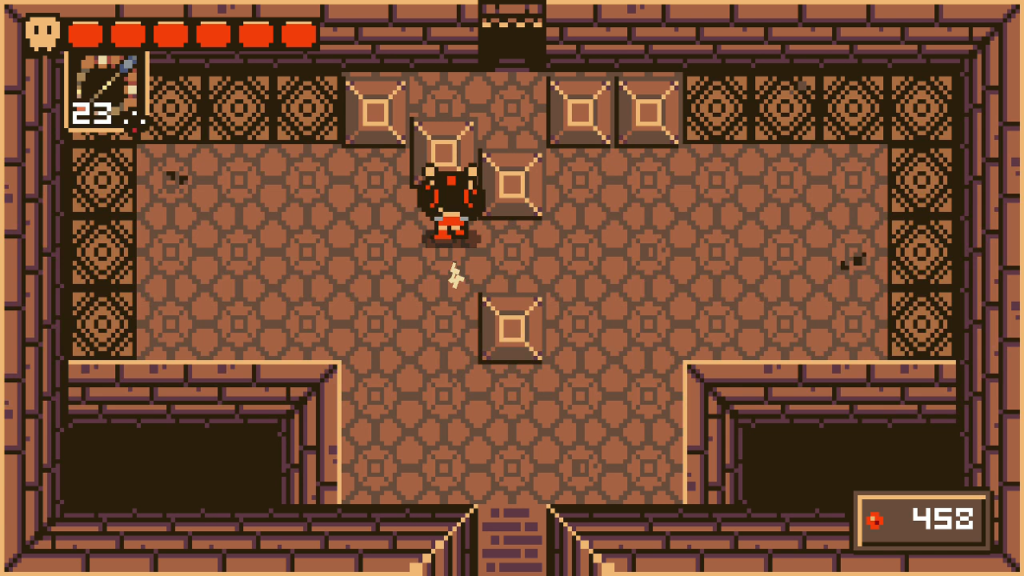
If the dungeons rely too heavily on a single kind of puzzle, it’s the block-pushing ones. Many rooms Sarissa enters are filled with blocks which prevent passage forward. Most of these blocks are immovable. Some can be pushed, but only for a short distance, whereupon they become as fixated as their neighbors. Movable and immovable blocks are indistinguishable. The only way to find which ones can be moved is to press Sarissa against every single one of them. Finding the correct direction and order to push these blocks to create a path forward is where Saga of the Moon Priestess becomes repetitive. Frustratingly, there’s even a puzzle late in the adventure where the block can be pushed all the way across the room, but only for this one block in this one room. Puzzles that only work by suddenly and silently changing the rules the videogame has previously followed are a cruel trick on the player.
Saga of the Moon Priestess’s weakest aspect is combat. Sarissa is a sluggish player character, moving slower than most enemies and thrusting her spear at a lethargic pace. Much of the challenge is brought by learning to work around these shortcomings. Enemies must be approached carefully or else they will blunder straight into Sarissa before I can react. This paradoxically makes the earliest moments of the adventure the hardest; Sarissa’s initially-limited health pool makes early mistakes far more costly than ones made later, when upgrades, access to more healing options, and the addition of ranged weapons to her arsenal minimizes their impact.
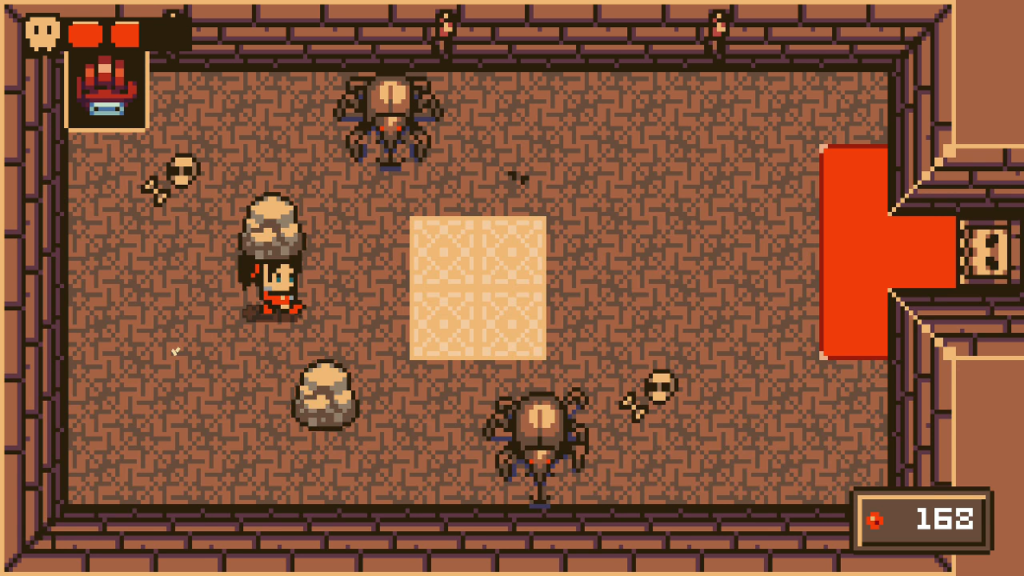
I feel Sarissa’s shortcomings in combat most acutely during the boss battles where her slow speed proves the greatest liability. One battle pits her against a pair of giant beetles who must be stunned with boulders before they can be damaged; Sarissa’s laborious lifting animation ensures one of the beetles nearly always collides with her before she can throw the boulder. Another battle against a giant squid is made irritating by how closely it pursues Sarissa as she runs to safety, compounded by the limited number of bombs she can carry which are its only weakness. These bosses are challenging, and not in the “fun and fair” way but in the “aggravating and punishing” way.
Another weak point is Saga of the Moon Priestess’ overall structure. It is so confident I will be comfortable in its Link’s Awakening roots that it does not trouble itself with giving directions on where Sarissa should go and what she must do. It’s only due to my intimate knowledge of its inspiration that I know she should be looking for a nearby dungeon.
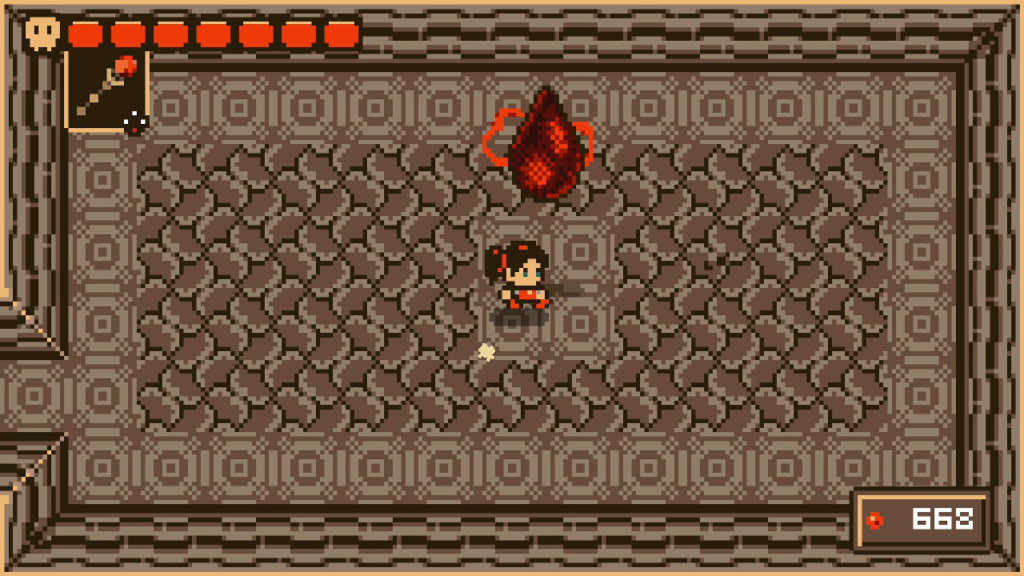
How completing dungeons will lead Sarissa to the prince is something that is never made clear. There are no MacGuffins hidden in their bowels which unlock the barrier sealing the final encounter. There are no Sages waiting to be rescued who can reveal the mastermind’s true form. Sarissa must complete every dungeon in succession to reach the final boss because that’s how Link’s Awakening works. Saga of the Moon Priestess is not devoid of plot or dialog, but it is frustratingly bare of exposition. I worry how players not already familiar with The Legend of Zelda may feel about its lack of direction, though its small scale may make this worry less of an issue than I imagine.
Structural problems extend all the way to the adventure’s ending. In The Legend of Zelda, there is normally a gap between the final dungeon and the proper final boss, who lurks in their own area elsewhere on the map. Not so in Saga of the Moon Priestess, whose final boss appears at the end of a regular dungeon, appearing without warning or foreshadowing. Not only does this make the story end without a recognizable climax, Sarissa must also make a special trip outside the final dungeon once she finds its special item to obtain the few prizes still unclaimed in the overworld map.
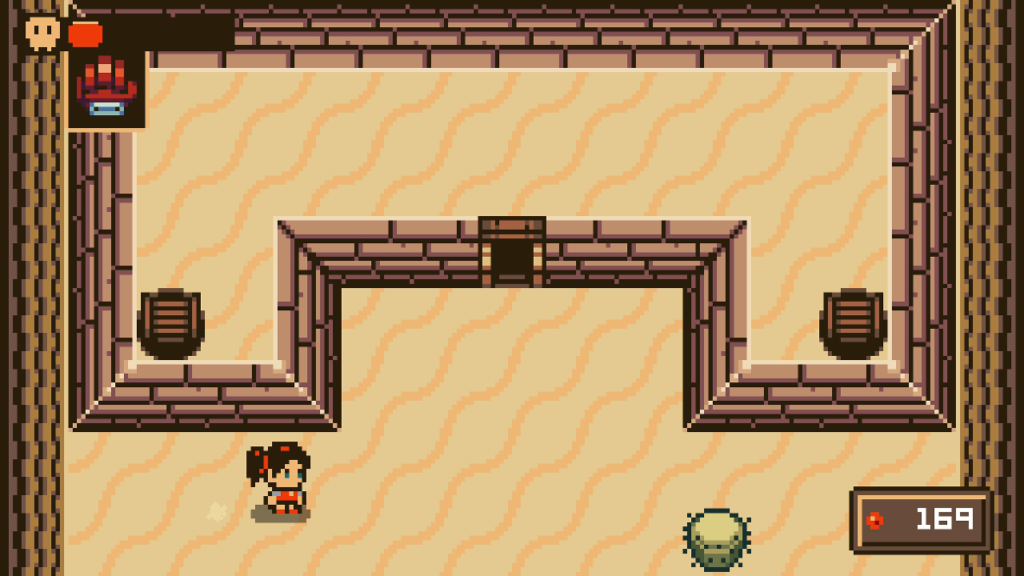
There’s no sense of rising action in Saga of the Moon Priestess, of a growing sense of finality and inevitability to Sarissa’s quest. It just suddenly ends, the path leading there interrupted by frequent detours as Sarissa veers off the main path to gather optional upgrades. This causes the entire journey, already brief at a mere three to four hours, to blend together into a single sensation. It’s warm and comforting as it evokes Link’s Awakening, but also abrupt and fleeting as it comes to an end. If any of the design could be notably improved, it would be a narrative thrust that makes me more engaged with Sarissa’s adventure and leaves with me clearer feelings about what she accomplishes.
My time with Saga of the Moon Priestess is sadly not a bug-free one. The Swap Chain was a frequent culprit. If Sarissa is hit by enemies or projectiles mid-swap, it can push her off target, potentially down a pit, inside a wall, or in one memorable moment, onto a screen of garbage graphics I could only escape by shutting down the entire app and resuming from a previous save.
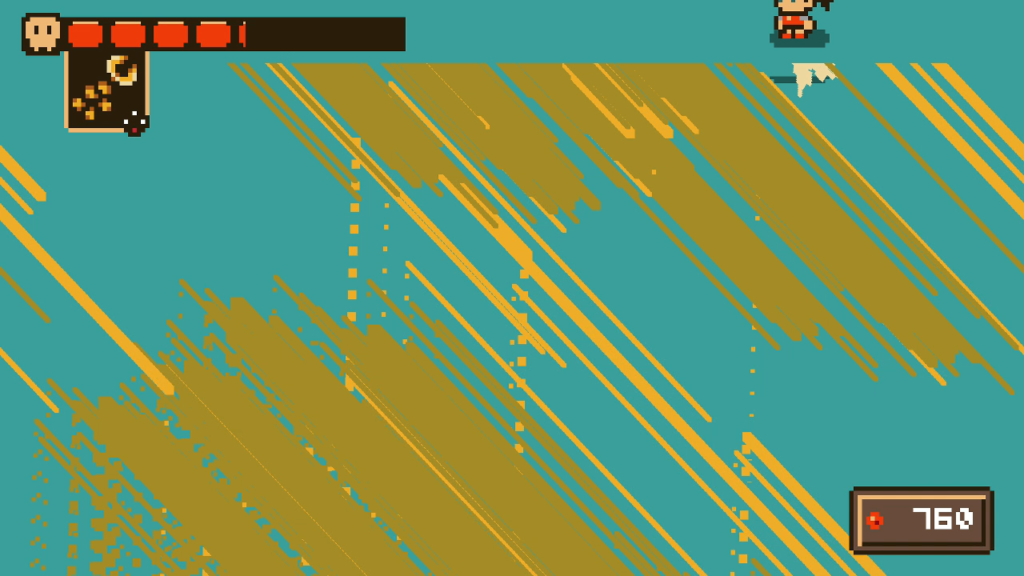
I also encountered strange behavior in the fourth dungeon. At some point most of its puzzles solved themselves, all doors unlocked, and all enemies—including the dungeon boss—disappeared. I circled the dungeon at least three times looking for a boss and there simply wasn’t one. Given the structural problems I described earlier, this left me with no choice but to take Sarissa to the next dungeon with the disconcerting feeling she hadn’t accomplished anything in the last one. Her adventure still concluded as though that fourth dungeon proceeded without incident.
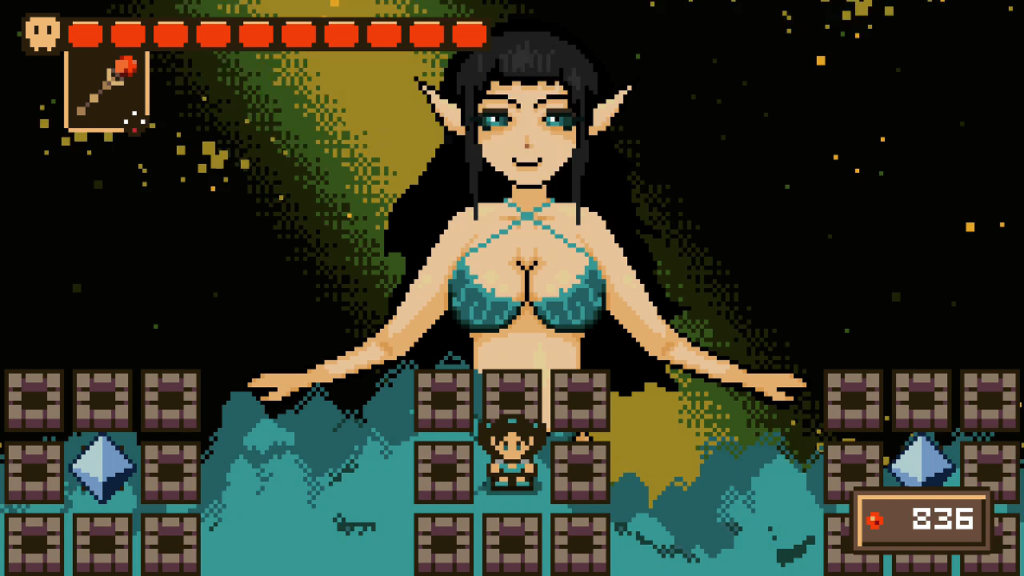
Saga of the Moon Priestess earns the backhanded compliment that it’s good mostly because The Legend of Zelda: Link’s Awakening is good. It’s not completely derivative, but it follows its tracks in the videogame design snow methodically enough to be unmistakable. Its main problems are a lack of polish. Sarissa is a little too slow to effectively react to her enemies. The structure of her adventure is not clearly communicated and lacks vital signposting to give a sense of progress and accumulation. Bugs abound, including at least two that significantly impact my experience. I still enjoy Saga of the Moon Priestess, but that’s probably the young Link’s Awakening fan in me flooding my pleasure centers with nostalgia. It’s not bad, and that’s the nicest thing I can say about it.